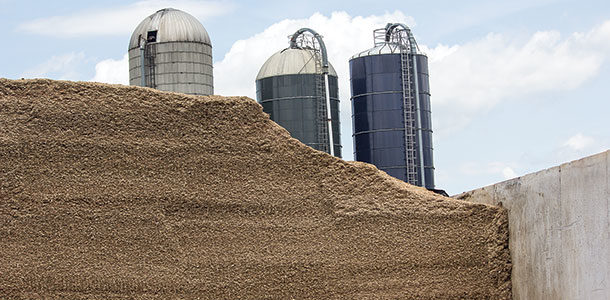To read this article in Spanish, click here.
Even when a farm does everything right prior to feedout, silage piles that are subjected to less-than-ideal face management have the potential for massive spoilage. It is like a football team taking the winning drive to the 1-yard line and fumbling the ball away. Prior to the fumble, there was precise coordination and probably a few great plays. However, the last play is the one that will stick in everyone’s mind until the following year. A farm’s forage team could have thought through every aspect of their forage program and harvest, but potential missteps around the time of feeding can lead to increased dry matter (DM) loss and silage with lower nutritive value.
Silage density
Oxygen exposure to the silage mass must be managed to reduce spoilage at the silage face. Research has shown that oxygen penetration into a silage mass can be extensive (approximately 13 feet in depth). Harvest practices that promote an adequate silage density will help in limiting the small pores within a silage pile where oxygen can penetrate during feedout.
Historically, silage consultants have recommended a silage density goal of a minimum of 15 pounds of dry matter per cubic foot. However, as piles and equipment have become progressively larger and our understanding of the importance of silage density has improved, so have the densities achieved on-farm. In a recent silage survey we conducted across 26 farms in the Midwest, corn silage density averaged 20.7 pounds of dry matter per cubic foot. An increase in recommended minimum density by silage consultants might be in order. It is evident that achieving greater silage density promotes dry matter recovery and feed quality while reducing the risk of spoilage at the silage face.
Facing equipment and strategy
Several types of equipment are currently available to assist in removing feed while minimizing the disturbance of the remaining silage in the pile. Rakes and mechanical silage facers and cutters can reduce silage disturbance and the potential penetration of oxygen into the silage mass. Never dig into or lift the silage face with equipment. This allows for oxygen to penetrate deep into the silage mass, increasing the risk of spoilage.
Safety is the top priority and impacts the facing strategy as well. Remember, no silage pile is ever safe. Never shave in a way that creates an overhang at the top of the pile. Much like a cornice of snow at the top of a mountain, this overhanging feed will break loose, avalanche and crush whatever may be beneath. This can be avoided if piles are shaped so that the peak height is never taller than what the available equipment can safely reach. In the same vein, silage faces should never be undercut, as undercut piles are extremely unstable.
Feeders should maintain a silage face that is smooth and flat to limit the surface area exposed to oxygen. It is ideal that the silage face be either perpendicular to or slightly laid back away from the open end of the silage pile. Maintaining a face perpendicular to the ground allows for precipitation to shed and minimizes the opportunity for water to accumulate in the feed. Due to safety concerns, many farms no longer maintain a face perpendicular to the ground; instead, they shave the pile so that the top of the face is ever so slightly angled away from the area where the feeder operates. This is done with consideration for the safety of employees who may have to go on top of the pile to remove tires and cut back plastic for future feedings.
Feedout rate
Feedout rate is one of the most important items to consider in reducing the risk of spoilage at the pile face. During the summer months, the recommended minimum feedout rate is 12 inches per day. During the cooler winter months, a minimum feedout rate of at least 6 inches per day should be sustained. Regional climatic differences may necessitate increased feedout rates, especially where high heat and humidity are common. Feedout rates beyond the recommendations of 6 to 12 inches per day can help in staying ahead of spoilage microorganisms.
Every farm is unique; managers should consider what is a reasonable feedout rate for their silage piles and make plans to achieve it. For example, let’s say it is summer and your feedout rate is 6 inches per day. Because your silage pile is adequately packed, oxygen penetrates 3 feet into the face of the pile. This means that the silage shaved off the face today has been exposed to oxygen for six days. During those six days, oxygen has been reintroduced to the silage. Yeasts and molds have started to consume valuable nutrients, and avoidable spoilage is now present.
Dry matter losses due to spoilage microorganisms should not be assumed to be uniform across a silage mass or a portion of the mass. Spoilage microorganisms consume valuable nutrients (such as soluble fibers, sugars, starches and proteins) in silage when given the opportunity, leaving behind a silage of lower nutrient quality to be fed to cattle.
Contrasting the previous example, let’s say your feedout rate is 12 inches per day, so the time silage is exposed to oxygen is reduced by half. With this reduction in oxygen exposure, the risk of spoilage microorganism proliferation is mitigated and more nutrients are preserved and available to cattle for consumption.
Spoilage
Visible mold in silage faces is often a result of excessive oxygen exposure. Speciation of molds by a reputable lab is required to determine the exact type of mold present and any potential mycotoxins it may produce. It is important to remember that, by the time visible mold appears in a silage face, spoilage has been present for an extended amount of time, reducing dry matter recovery and nutritive value.
During all spoilage, heat is produced. In areas of the silage face where nonvisible spoilage occurs, hotspots can be identified using temperature probes or infrared cameras. When these spots are identified, farm managers and consultants can quickly develop a plan to prevent further spoilage.
As farm margins tighten, your silages – and the nutrients they contain – become even more valuable. Don’t let yourself fumble at the 1-yard line with your next silage pile. Put careful thought into your feedout strategy. Practice and teach employees proper face management to retain more DM, feed higher-quality silage to your cows, and get the most from every acre and ton of forage.







